Watercolor painting is a beautiful and versatile medium that has been used by artists for centuries. Its luminous and transparent qualities make it a favorite among beginners and experienced artists alike. If you are new to watercolor painting, there are a few key tips and techniques that can help you get started and create stunning works of art. In this beginner’s guide, we will cover everything you need to know to begin painting with watercolors.
The first step in watercolor painting is to gather your materials. You will need watercolor paper, watercolor paints, brushes, water, and a palette. Watercolor paper is specially designed to withstand the wetness of the paint and to showcase the vibrant colors of watercolors. When choosing watercolor paper, look for one that is at least 140 lb in weight, as lighter weight paper may warp or buckle when wet. Watercolor paints come in tubes or pans, and you can choose from a wide range of colors to create your palette. Brushes come in various shapes and sizes, and it is important to select ones that are suitable for watercolor painting, such as round, flat, and mop brushes. Finally, you will need water to dilute your paint and a palette to mix your colors.
Once you have gathered your materials, it is time to start painting. One of the most important tips for beginners is to start with a simple and easy subject. Flowers, landscapes, and still lifes are great subjects for beginners to practice their skills. Before you begin painting, it is helpful to sketch your subject lightly with a pencil to establish the composition and placement of objects on the paper.
Watercolor painting is all about layering and building up colors gradually. To start, wet your brush and pick up some paint from your palette. You can dilute the paint with water to create different shades and tones. Begin by painting the lightest colors first and gradually build up layers of paint to create depth and dimension in your painting. It is important to let each layer dry completely before adding the next layer to avoid muddy colors and bleeding.
One of the unique qualities of watercolor painting is its transparency. Watercolors can be layered and blended to create soft and flowing washes of color. To achieve this effect, it is important to control the amount of water on your brush and paper. Wet-on-wet painting involves applying wet paint to a wet paper surface, which creates soft and diffused edges. Wet-on-dry painting involves applying wet paint to a dry paper surface, which creates sharper and more defined edges. Experiment with both techniques to see which one works best for your painting.
Another important technique in watercolor painting is the use of masking fluid. Masking fluid is a liquid latex that can be applied to specific areas of your painting to preserve the white of the paper. Once the masking fluid dries, you can paint over it with watercolor and then remove the masking fluid to reveal the white areas. This technique is useful for creating highlights and detailed elements in your painting.
As you gain more experience with watercolor painting, you can experiment with different techniques and approaches to create unique and interesting effects. Some artists like to use salt or rubbing alcohol to create texture and patterns in their paintings. Salt sprinkled on wet paint creates a granulated effect, while rubbing alcohol mixed with paint creates a marbled effect. You can also use a dry brush technique to create texture and dry brush strokes in your painting.
Watercolor painting is a versatile medium that allows for a wide range of artistic expression. Whether you prefer traditional and realistic paintings or abstract and experimental works, watercolors can accommodate your artistic style. Don’t be afraid to make mistakes or experiment with new techniques – after all, art is about creativity and self-expression.
In conclusion, watercolor painting is a beautiful and rewarding medium that is perfect for beginners to start their artistic journey. With a few key tips and techniques, you can create stunning works of art that showcase the luminous and transparent qualities of watercolors. Remember to gather your materials, start with a simple subject, practice layering and blending, and experiment with different techniques to create unique and interesting effects in your paintings. Happy painting!

